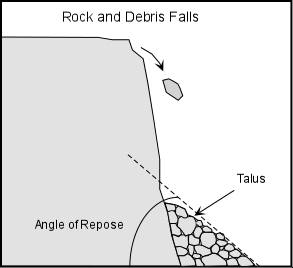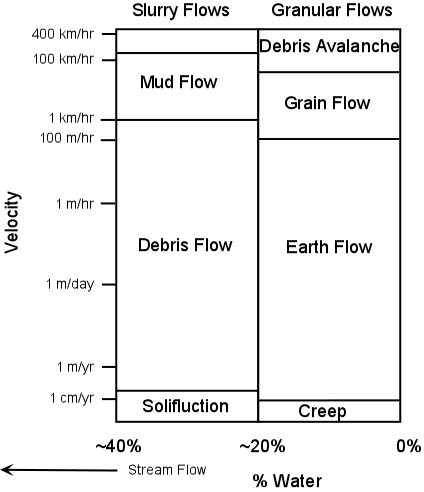Mass Wasting and its Human Impacts
Mass Wasting and its Human Impacts
Mass-Wasting is defined as the down slope movement of rock and regolith near the Earth's surface mainly due to the force of gravity. Mass-wasting is an important part of the erosional process, as it moves material from higher elevations down to lower elevations where transporting agents like streams and glaciers can then pick up the material and move it to even lower elevations. Mass-wasting processes are occurring continuously on all slopes; some mass-wasting processes act very slowly, others occur very suddenly, often with disastrous results. Any perceptible down slope movement of rock or regolith is often referred to in general terms as a landslide. However, as we will see, landslides can be classified in a much more detailed way that reflects the mechanisms responsible for the movement and the velocity at which the movement occurs.
As human populations expand and occupy more and more of the land surface, mass-wasting processes become more likely to affect humans. The table below (taken from your text) shows the impact of mass-wasting processes on human life over the last century.
| Year | Location | Fatalities | |
|---|---|---|---|
| 1916 | Italy, Austria | Landslide | 10,000 |
| 1920 | China | Earthquake triggered landslide | 200,000 |
| 1945 | Japan | Flood triggered landslide | 1,200 |
| 1949 | USSR | Earthquake triggered landslide | 12,000-20,000 |
| 1954 | Austria | Landslide | 200 |
| 1962 | Peru | Landslide | 4,000-5,000 |
| 1963 | Italy | Landslide | 2,000 |
| 1970 | Peru | Earthquake related debris avalanche | 70,000 |
| 1985 | Columbia | Mudflow related to volcanic eruption | 23,000 |
| 1987 | Ecuador | Earthquake related landslide | 1,000 |
Knowledge about the relationships between local geology and mass-wasting processes can lead to better planning that can reduce vulnerability to such hazards. Thus, we will look at the various types of mass-wasting processes, their underlying causes, factors that affect slope stability, and what humans can do to reduce vulnerability and risk due to mass-wasting hazards.
Types of Mass-Wasting Processes
The down-slope movement of material, whether it be bedrock, regolith, or a mixture of these, is commonly referred to as a landslide. All of these processes generally grade into one another, so classification of such processes is somewhat difficult. We will use the classification in your textbook, dividing mass-wasting processes into two broad categories.
- Slope Failures - a sudden failure of the slope resulting in
transport of debris down hill by sliding, rolling, falling, or
slumping.
- Sediment Flows - debris flows down hill mixed with water or air.
- Slumps - types of slides wherein downward rotation of rock or regolith occurs along a concave-upward curved surface. The upper surface of each slump block remains relatively undisturbed, as do the individual blocks. Slumps leave arcuate scars or depressions on the hill slope. Slumps can be isolated or may occur in large complexes covering thousands of square meters. They often form as a result of human activities, and thus are common along roads where slopes have been oversteepened during construction. They are also common along river banks and sea coasts, where erosion has under-cut the slopes. Heavy rains and earthquakes can also trigger slumps.

- Falls - Rock falls occur when a piece of rock on a steep slope becomes dislodged and falls down the slope. Debris falls are similar, except they involve a mixture of soil, regolith, vegetation, and rocks. A rock fall may be a single rock or a mass of rocks, and the falling rocks can dislodge other rocks as they collide with the cliff. Because this process involves the free fall of material, falls commonly occur where there are steep cliffs. At the base of most cliffs is an accumulation of fallen material termed talus.

- Slides - Rock slides and debris slides result when rocks or debris slide down a pre-existing surface, such as a bedding plane, foliation surface, or joint surface (joints are regularly spaced fractures in rock that result from expansion during cooling or uplift of the rock mass). Piles of talus are common at the base of a rock slide or debris slide. Slides differ from slumps in that there is no rotation of the sliding rock mass along a curved surface.

Sediment Flows
Sediment flows occur when sufficient force is applied to rocks and regolith that they begin to flow down slope. A sediment flow is a mixture of rock, and/or regolith with some water or air. They can be broken into two types depending on the amount of water present.
- Slurry Flows - are sediment flows that contain between about 20 and 40% water. As the water content increases above about 40% slurry flows grade into streams. Slurry flows are considered water-saturated flows.
- Granular Flows - are sediment flows that contain between 0 and 20% water. Note that granular flows are possible with little or no water. Fluid-like behavior is given these flows by mixing with air. Granular flows are not saturated with water.

Each of these classes of sediment flows can be further subdivided on the basis of the velocity at which flowage occurs.
- Slurry Flows
- Solifluction -flowage at rates measured on the order of
centimeters per year of regolith containing water. Solifluction
produces distinctive lobes on hill slopes (see figure. 6.4 and
6.5 in your text). These occur in areas where the soil remains
saturated with water for long periods of time.
- Debris Flows
- these occur at higher velocities than solifluction, with velocities between 1 meter/yr and 100 meters/hr and often result from heavy rains causing saturation of the soil and regolith with water. They sometimes start with slumps and then flow down hill forming lobes with an irregular surface consisting of ridges and furrows (see figure 6.4 in your text).
- Mudflows
- these are a highly fluid, high velocity mixture of sediment and water that has a consistency ranging between soup-like and wet concrete. They move at velocities greater than 1 km/hr and tend to travel along valley floors. These usually result from heavy rains in areas where there is an abundance of unconsolidated sediment that can be picked up by streams. Thus after a heavy rain streams can turn into mudflows as they pick up more and more loose sediment. Mudflows can travel for long distances over gently sloping stream beds. Because of their high velocity and long distance of travel they are potentially very dangerous. As we have seen, mudflows can also result from volcanic eruptions that cause melting of snow or ice on the slopes of volcanoes, or draining of crater lakes on volcanoes. Volcanic mudflows are often referred to as lahars. Some lahars can be quite hot, if they are generated as a result of eruptions of hot tephra.
- Granular Flows
- Creep - the very slow, usually continuous movement of regolith
down slope. Creep occurs on almost all slopes, but the rates vary.
Evidence for creep is often seen in bent trees, offsets in roads and
fences, and inclined utility poles (see figure 6.9 in your text).
- Earthflows - are usually associated with heavy rains and move at
velocities between several cm/yr and 100s of m/day. They usually
remain active for long periods of time. They generally tend to be
narrow tongue-like features that begin at a scarp or small cliff
(see figure 6.11 in your text)
- Grain Flows - usually form in relatively dry material, such as a
sand dune, on a steep slope. A small disturbance sends the dry
unconsolidated grains moving rapidly down slope.
- Debris Avalanches - These are very high velocity flows of large
volume mixtures of rock and regolith that result from complete
collapse of a mountainous slope. They move down slope and then can
travel for considerable distances along relatively gentle slopes.
They are often triggered by earthquakes and volcanic eruptions.
Mass-wasting in cold climates is governed by the fact that water is frozen as ice during long periods of the year. Ice, although it is solid, does have the ability to flow, and freezing and thawing cycles can also contribute to movement.
- Frost Heaving - this process is large contributor to creep in cold climates. When water saturated soils freeze, they expand, pushing rocks and boulders on the surface upward perpendicular to the slope. When the soil thaws, the boulders move down vertically resulting in a net down slope movement.
- Gelifluction - Similar to solifluction, this process occurs when the upper layers of soil thaw during the warmer months resulting in water saturated soil that moves down slope.
- Rock Glaciers - a lobe of ice-cemented rock debris (mostly rocks with ice between the blocks) that slowly moves downhill.
Mass wasting processes also occur on steep slopes in the ocean basins. A slope failure can occur due to over-accumulation of sediment on slope or in a submarine canyon, or could occur as a result of a shock like an earthquake. Slumps, debris flows, and landslides are common.

